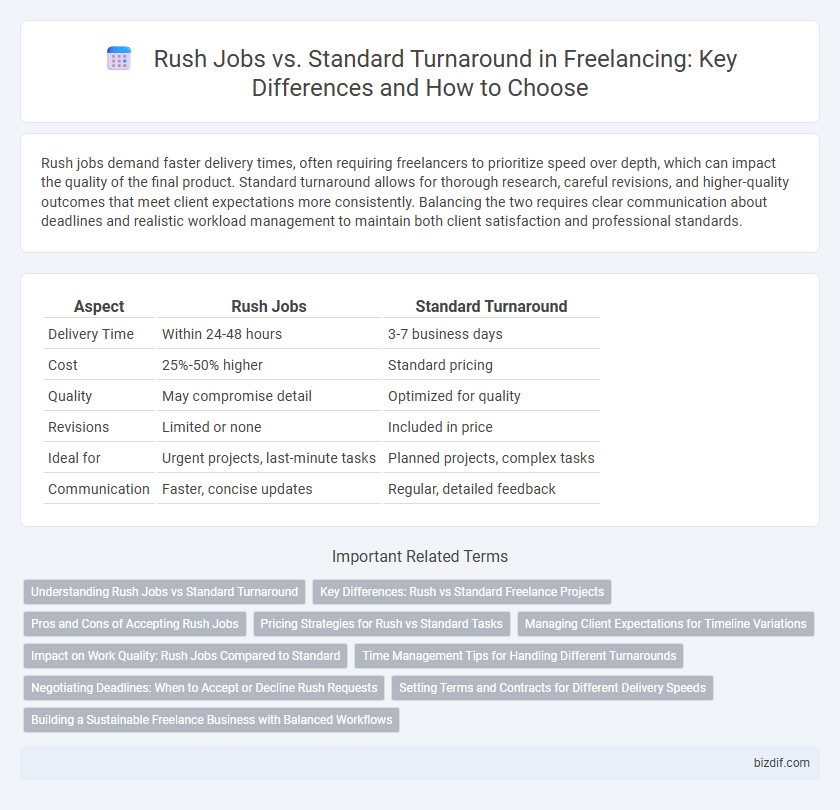Rush jobs demand faster delivery times, often requiring freelancers to prioritize speed over depth, which can impact the quality of the final product. Standard turnaround allows for thorough research, careful revisions, and higher-quality outcomes that meet client expectations more consistently. Balancing the two requires clear communication about deadlines and realistic workload management to maintain both client satisfaction and professional standards.
Table of Comparison
| Aspect | Rush Jobs | Standard Turnaround |
|---|---|---|
| Delivery Time | Within 24-48 hours | 3-7 business days |
| Cost | 25%-50% higher | Standard pricing |
| Quality | May compromise detail | Optimized for quality |
| Revisions | Limited or none | Included in price |
| Ideal for | Urgent projects, last-minute tasks | Planned projects, complex tasks |
| Communication | Faster, concise updates | Regular, detailed feedback |
Understanding Rush Jobs vs Standard Turnaround
Rush jobs demand expedited delivery, often requiring completion within hours or a day, which can lead to higher fees due to increased urgency and resource allocation. Standard turnaround times usually range from several days to weeks, allowing for thorough planning, quality assurance, and client collaboration, resulting in more polished outcomes. Understanding the trade-offs between rush jobs and standard turnaround is crucial for freelancers to manage workload, maintain quality standards, and set appropriate pricing strategies.
Key Differences: Rush vs Standard Freelance Projects
Rush freelance projects demand expedited delivery, often within 24 to 48 hours, resulting in higher rates due to urgent resource allocation and limited revision opportunities. Standard turnaround projects typically span several days to weeks, allowing for detailed planning, multiple revisions, and thorough quality assurance. Clients opting for rush jobs prioritize speed and immediate results, while standard projects emphasize comprehensive development and refinement.
Pros and Cons of Accepting Rush Jobs
Accepting rush jobs in freelancing offers the advantage of higher pay rates and the opportunity to build client trust through quick turnaround times. However, these jobs often come with increased stress, tighter deadlines, and potential compromises on quality compared to standard turnaround projects. Freelancers must weigh the benefits of fast payment against the risk of burnout and reduced work-life balance when choosing rush assignments.
Pricing Strategies for Rush vs Standard Tasks
Freelancers often implement tiered pricing strategies where rush jobs incur premium rates, typically 25-50% higher than standard turnaround tasks, to compensate for the expedited workload and resource allocation. Pricing models consider factors such as project complexity, deadline urgency, and the impact on the freelancer's schedule, ensuring profitability while maintaining client satisfaction. Transparent communication about these differential rates helps manage expectations and reinforces the value of on-time delivery versus quick turnaround services.
Managing Client Expectations for Timeline Variations
Clearly communicating the differences between rush jobs and standard turnaround times helps manage client expectations effectively. Offering transparency about potential additional costs and quality trade-offs for expedited work reduces misunderstandings. Setting realistic deadlines based on project complexity ensures timely delivery and maintains client satisfaction.
Impact on Work Quality: Rush Jobs Compared to Standard
Rush jobs often lead to compromised work quality due to limited time for thorough research, revision, and quality assurance, increasing the likelihood of errors or overlooked details. Standard turnaround times allow freelancers to deliver polished, well-researched content or projects, enhancing client satisfaction and long-term reputation. Prioritizing reasonable deadlines ensures higher accuracy, creativity, and overall project success in freelancing engagements.
Time Management Tips for Handling Different Turnarounds
Managing rush jobs versus standard turnaround projects requires precise scheduling and clear priority setting to maintain quality and meet deadlines. Allocating specific time blocks for urgent tasks while keeping regular slots for standard assignments enhances productivity and reduces stress. Utilizing tools like time tracking apps and setting realistic milestones ensures efficient handling of varying workload demands in freelancing.
Negotiating Deadlines: When to Accept or Decline Rush Requests
Rush jobs often demand faster turnaround times, increasing stress and risking quality compromise compared to standard deadlines. Freelancers should evaluate workload, resource availability, and project complexity before accepting rush requests to ensure feasible delivery without burnout. Clear communication with clients about realistic deadlines helps negotiate terms that protect both freelancer well-being and project standards.
Setting Terms and Contracts for Different Delivery Speeds
Setting clear terms and contracts for rush jobs versus standard turnaround ensures expectations are managed and payment is secured upfront. Rush jobs often require premium pricing clauses and explicit deadlines to compensate for the accelerated delivery and potential overtime. Standard turnaround contracts typically allow more flexible timelines and may include milestones that reflect a balanced workflow without sacrificing quality.
Building a Sustainable Freelance Business with Balanced Workflows
Rush jobs often demand expedited delivery but can disrupt a freelancer's workflow and increase stress levels. Standard turnaround times allow for balanced project management, ensuring higher quality output and client satisfaction. Establishing clear boundaries between rush and regular projects helps build a sustainable freelance business with consistent income and manageable workloads.
rush jobs vs standard turnaround Infographic

 bizdif.com
bizdif.com